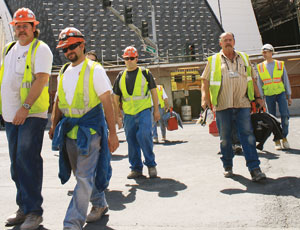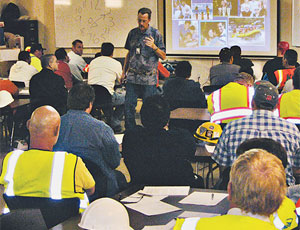My first workday at CityCenter—the Las Vegas Strip’s $8.6-billion mixed-use development, the country’s largest privately financed project—started last fall at the pitch- black hour of 6:30 a.m. I was nervous about my decision to shadow new construction hires during their safety training. Six workers had died on the project since 2007, sparking pickets and pressure that led to mandatory safety training. In the back of my mind was the fact that my brother-in-law, Darin, had suffered a near-fatal construction accident about a year earlier at another project and had returned to work at CityCenter. Now, months after my first day of training at CityCenter, the project’s safety crisis seems strangely distant, pushed from mind by the headlines about the just-concluded financial pact between the developers to finish the project. But I was determined to see for myself what happens in the middle of a safety turnaround.

So there I was on a cool, eerily quiet October morning when a crush of ragged work cars and pickup trucks converged onto Dean Martin Drive for the morning shift change. The sole access road onto the jobsite is a narrow stretch of asphalt that takes an hour to navigate a quarter mile. Some workers riding motorcycles weave in between cars for shorter travel times. New hires are immediately corralled into a mandatory two-hour orientation held inside a makeshift classroom in the basement of the employee parking garage. A safety trainer from Perini Building Co., the project’s Framingham, Mass.-based lead contractor, does the talking.
It feels like the first day of school. There is excited talk, off-color jokes, old-friend reunions and nervous glances. People size one another up and separate into clusters—ironworkers, carpenters and Spanish-speaking laborers. The room at the all-union project fills with 70 men ranging in age from their 20s to their 50s. Everyone has been called up to meet City- Center’s insatiable manpower needs. The 18.7-million-sq-ft project is the equivalent of nine Empire State Buildings going up simultaneously. At the time the Empire State Building was constructed, expectations were that one worker would die for each floor that was built: the final number was much lower. CityCenter thankfully is judged by today’s safer standard.
Outfitted in frayed blue jeans and cotton T-shirts, the workers share a similar style: goatees and handlebar mustaches, tattooed forearms and stiff leather boots. Everyone carries plastic lunch coolers and weathered hardhats caked with stickers of employers, projects and skill certifications. The labels serve as merit badges, narrating prior work history and experience. Andy Campbell, a wiry Perini safety trainer and former paramedic, delivers a blunt and at times abrasive orientation speech. Everything is translated into Spanish.
“A lot of people are talking smack about this project,” Campbell says. “We are doing our best to remove the knuckleheads to make it as safe as possible.”
CityCenter earned the grisly nickname “CityCemetary” from its trade workers because of the six well-publicized deaths and the 1,000 accidents requiring medical attention. The fatalities spanned 18 months, starting in February 2007, when a concrete form collapsed and crushed carpenter Bobby Lee Tohannie, 44. The string ended in May 2008, when a crane counterweight system crushed operating engineer Dustin Tarter, 39, as he serviced the machine. Unions, workers and elected officials pressured the project owners and managers into providing 10 hours of required federal safety training for everyone on-site. I am part of the new class.
Perini staff members hand out employment paperwork, with copies translated into Spanish. Rules prohibit alcohol and drugs, graffiti, wrestling, running, unreported accidents and horseplay. Employees must sign legal waivers acknowledging their full understanding of work policies and the consequences of violations. Failure to follow any policy can result in immediate termination and lifetime banishment from MGM Mirage projects. Violators additionally face a minimum of a one-year suspension from Perini jobs. To help make his point, Campbell has stacked revoked work cards, including some from superintendents and managers, ankle high in front of the room. The talk emphasizes workers’ responsibility for their own safety and welfare as well as those working around them.
“A foreman or project manager oversees at least 30 people,” Campbell says. “They are not standing over us like an umpire watching every move we make.”
Live To Spend
An average CityCenter journeyman earns $80,000 a year—more than many college graduates. Project officials want workers to take home fat paychecks and live to spend them, Campbell says. It is a message repeated like a mantra during orientation and training. A deepening recession and rising unemployment are other touchstones Campbell uses to unite the ideas of employment, safety and productivity. Break the rules and you are out. “Is it worth losing your job?” he asks.
Campbell gives the same orientation speech once a day to about 100 new workers. “Communicate with each other, work together, and we will get this job done,” he says.
In his orientation, Campbell never refers directly to CityCenter’s grim history of deadly accidents. I cannot imagine that it is not the subject of late-night diningroom-table talks. But it is considered bad luck to speak...


Post a comment to this article
Report Abusive Comment